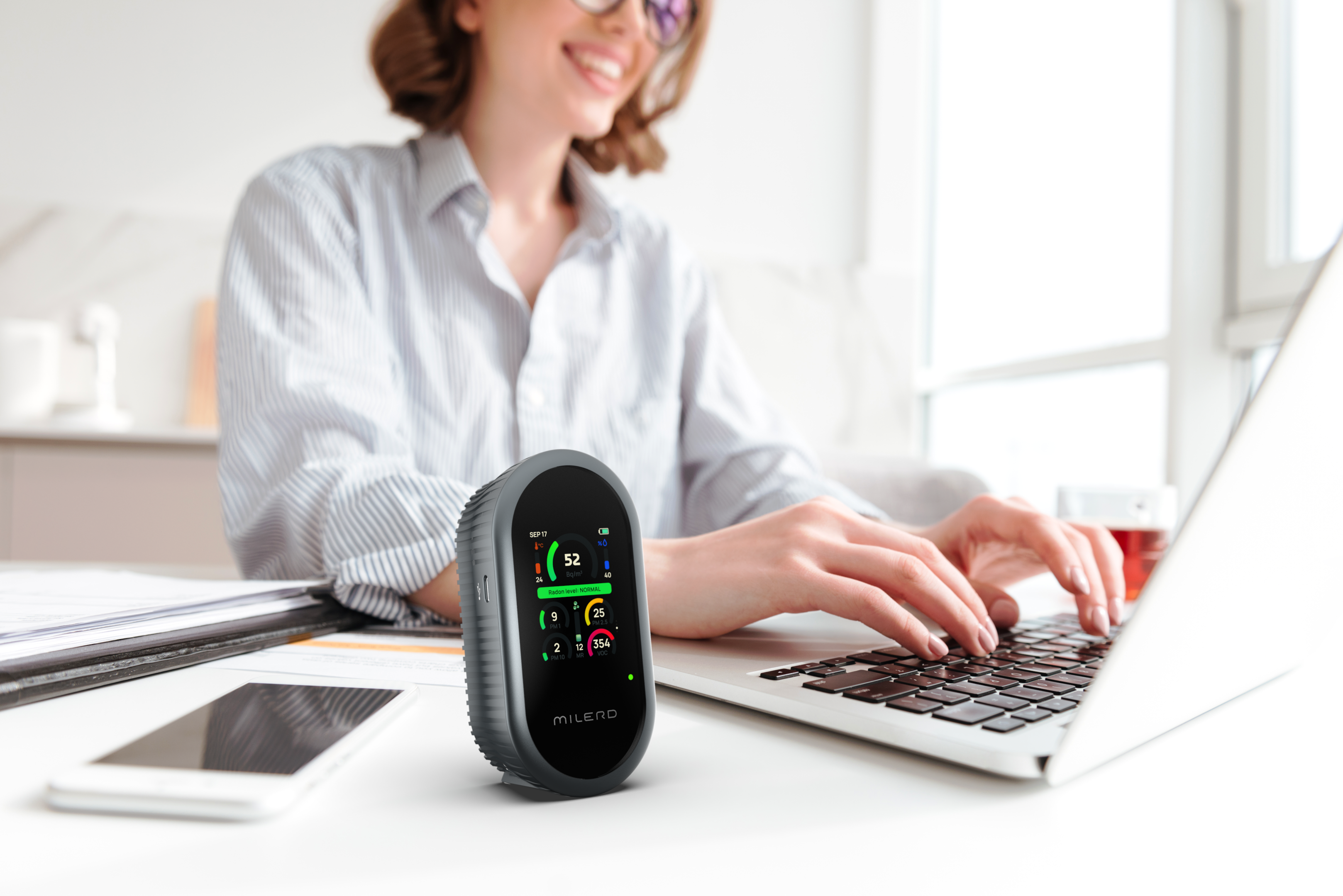La calidad del aire interior es vital para tu salud. Un aire interior deficiente puede causar alergias, problemas respiratorios y enfermedades crónicas. Este artículo te ayudará a comprender qué afecta la calidad del aire interior, identificar los contaminantes más comunes y aprender formas prácticas de mejorar el aire en tu hogar u oficina.
Puntos Clave
-
La Calidad del Aire Interior (IAQ) influye significativamente en la salud, especialmente en poblaciones vulnerables como niños y ancianos, destacando la necesidad de una ventilación adecuada y el control de contaminantes.
-
Los contaminantes interiores comunes provienen de materiales de construcción, productos domésticos y actividades diarias, por lo que es esencial identificarlos y mitigarlos para mejorar la IAQ y reducir los riesgos para la salud.
-
Las tecnologías avanzadas de monitoreo, como el Aero Q4 y el Aero Q8, permiten el seguimiento y la gestión en tiempo real de la calidad del aire interior, facilitando medidas proactivas para mejorar la salud y el bienestar.
Comprendiendo la Calidad del Aire Interior
La calidad del aire interior (IAQ) se refiere al estado del aire dentro de los edificios e instalaciones, el cual influye notablemente en la salud y el confort de los ocupantes. Para evaluar la IAQ de manera eficaz, se deben:
-
Recolectar muestras de aire interior
-
Monitorear los niveles de exposición entre los ocupantes
-
Examinar las superficies del edificio en busca de contaminantes
-
Simular la dinámica del flujo de aire
Considerando que las personas pasan aproximadamente el 90 % de su tiempo en interiores, es fundamental mantener altos estándares de calidad del aire interior.
La calidad del aire interior puede verse comprometida por varios factores, como sistemas de ventilación inadecuados, altos niveles de humedad y emisiones de fuentes internas que liberan gases o partículas en el ambiente. Una IAQ deficiente puede causar molestias y diversos problemas de salud, afectando especialmente a los grupos más vulnerables como niños y personas mayores. Por lo tanto, mantener una buena calidad del aire interior es esencial para promover un entorno saludable tanto en el hogar como en el trabajo.
Mantener índices adecuados de IAQ depende en gran medida de una ventilación eficaz combinada con un control cuidadoso de los contaminantes. Comprender estos factores y sus posibles efectos negativos en la salud permite implementar estrategias proactivas para mejorar los entornos interiores y, en consecuencia, el bienestar general.
Fuentes Comunes de Contaminantes del Aire Interior
La calidad del aire interior puede verse afectada por varios factores, entre ellos:
-
Emisión de compuestos orgánicos volátiles (COV) provenientes de materiales de construcción, mobiliario y productos como ambientadores
-
El uso de artículos domésticos como productos de limpieza e insecticidas que contribuyen a la contaminación del aire interior
-
Contaminantes generados por la combustión de combustibles en electrodomésticos como estufas de gas y chimeneas abiertas
-
Emisión de contaminantes interiores durante actividades rutinarias como cocinar, limpiar o fumar, entre otras acciones humanas que se originan dentro del hogar.
Los problemas de humedad en los edificios pueden favorecer la proliferación de moho, un factor que aumenta significativamente la concentración de contaminantes en interiores y deteriora la calidad del aire, representando riesgos para la salud de los ocupantes.
Reconocer las fuentes más comunes de estos contaminantes es fundamental para planificar intervenciones eficaces que mejoren la IAQ. Abordar estos factores desempeña un papel clave en la creación de espacios interiores más saludables, reduciendo los efectos negativos asociados con una mala calidad del aire.
Efectos en la Salud de una Mala Calidad del Aire Interior

La exposición a una mala calidad del aire interior puede provocar diversas complicaciones de salud, como:
-
Reacciones inmediatas como irritación en los ojos, nariz y garganta
-
Enfermedades crónicas como afecciones respiratorias y cardiacas
-
Empeoramiento de alergias existentes
-
Incremento de los síntomas en personas con enfermedades cardíacas preexistentes
Los efectos adversos de los contaminantes del aire interior pueden manifestarse poco después de la exposición o tardar años en aparecer, especialmente con concentraciones elevadas. La mayor vulnerabilidad de niños y ancianos subraya la importancia de una buena calidad del aire interior en viviendas, escuelas y espacios cerrados.
Reconocer los peligros potenciales de una IAQ deficiente es esencial para priorizar acciones que mejoren la calidad del aire en interiores, protegiendo la salud pública y promoviendo el bienestar general.
El Papel de la Ventilación en el Mantenimiento de la IAQ

La introducción de aire fresco del exterior en los espacios interiores es esencial para reducir la concentración de contaminantes y mejorar la calidad del aire interior. Los sistemas mecánicos, como los HVAC, son eficaces para ventilar los edificios, mientras que medios naturales como abrir las ventanas también contribuyen a expulsar el aire cargado de contaminantes, especialmente durante actividades que generan más emisiones.
El aire también penetra en los edificios de forma natural a través de rendijas y aberturas, favoreciendo el intercambio entre los ambientes interior y exterior. Los diseños de viviendas modernas suelen incluir sistemas de ventilación con recuperación de calor, que permiten conservar energía mientras mejoran la circulación y climatización. En cambio, una ventilación deficiente puede ocasionar un aumento peligroso de los niveles de contaminantes interiores.
Mediante el uso combinado de sistemas mecánicos y procesos naturales de ventilación, es posible mejorar considerablemente la calidad del aire interior y prevenir los riesgos derivados de una acumulación excesiva de contaminantes en suspensión.
Tecnologías Innovadoras para Monitorear la IAQ
Los avances tecnológicos han transformado la forma en que se monitorea y mejora la calidad del aire interior. La inteligencia artificial (IA) y el aprendizaje automático se utilizan ahora para detectar patrones complejos, anticipar tendencias de contaminación y predecir cambios en las condiciones del aire interior, permitiendo actuar de manera preventiva para mejorar la IAQ.
Los dispositivos de monitoreo de calidad del aire han evolucionado de unidades grandes y básicas a instrumentos pequeños y altamente sensibles que funcionan en conjunto con innovaciones del Internet de las Cosas (IoT) y la IA. Estos avances han mejorado notablemente la gestión de la salud pública al ofrecer herramientas esenciales para garantizar la seguridad ambiental mediante una supervisión y mitigación más eficaces de la contaminación del aire.
Evolución de los Monitores de Calidad del Aire
Los monitores de calidad del aire modernos han evolucionado desde sus formas voluminosas originales hasta convertirse en instrumentos elegantes y precisos. La integración de la tecnología IoT permite ahora un seguimiento en tiempo real de la calidad del aire interior con mayor precisión y comodidad. El uso de nanomateriales en la fabricación de sensores ha mejorado su exactitud mientras reduce el consumo energético.
Las investigaciones actuales se centran en desarrollar sistemas capaces de rastrear múltiples contaminantes simultáneamente. Estos avances en ingeniería ambiental son vitales para proteger la salud pública y el entorno mediante una mejor gestión de la calidad del aire.
Características de los Monitores Modernos de IAQ
Los monitores contemporáneos de calidad del aire interior, como el Aero Q4, están diseñados con interfaces intuitivas que facilitan su uso y comprensión de datos. El Aero Q4 ofrece monitoreo en tiempo real y notificaciones inmediatas sobre niveles peligrosos de radón, permitiendo una respuesta rápida ante condiciones ambientales riesgosas.
Los dispositivos de última generación utilizan una variedad de sensores para ofrecer un análisis completo del aire interior, detectando distintos contaminantes. Por ejemplo, el Aero Q8 mide:
-
partículas en suspensión
-
humedad
-
temperatura
-
riesgo de moho,
convirtiéndose en un instrumento multifuncional para la evaluación de la calidad del aire interior.
Ventajas de los Monitores Portátiles de IAQ
Los monitores portátiles de calidad del aire ofrecen la versatilidad necesaria para evaluar la calidad del aire en diversos entornos. Proporcionan evaluaciones instantáneas, ideales para obtener retroalimentación inmediata y realizar ajustes necesarios.
Estos dispositivos ayudan a científicos, autoridades y público general a identificar áreas con altos niveles de contaminación, cuantificar la magnitud de los contaminantes y tomar decisiones informadas. Esta adaptabilidad es clave para actuar rápidamente y mantener una buena calidad del aire interior en distintos lugares.
Cómo los Dispositivos Aero Q4 y Aero Q8 Mejoran la Calidad del Aire Interior
Los sistemas Aero Q4 y Aero Q8 están diseñados específicamente para detectar contaminantes interiores y ofrecer información crucial para mantener una buena calidad del aire. El Aero Q4 destaca en la detección de radón, mientras que el versátil Aero Q8 monitorea una amplia gama de parámetros de IAQ.
Estos dispositivos proporcionan acceso inmediato a datos en tiempo real sobre los indicadores de calidad del aire, permitiendo actuar de forma rápida ante cualquier problema. Equipados con funciones IoT, ambos modelos permiten la supervisión remota y envían notificaciones a través de aplicaciones móviles, garantizando un control constante del entorno interior.
Descripción del Aero Q4

El Aero Q4 actúa como un detector versátil de gas radón que mide con precisión la concentración de radón (Rn) en el entorno. Cuenta con una pantalla que muestra información en tiempo real, permitiendo a los usuarios supervisar la calidad del aire y recibir alertas cuando los niveles de radón superan los límites seguros.
Este dispositivo también funciona como higrómetro, midiendo la humedad relativa y la temperatura ambiente. Su diseño compacto y resistente lo hace ideal para diferentes espacios interiores, garantizando un funcionamiento confiable incluso en entornos de uso frecuente.
Descripción del Aero Q8

El Aero Q8 sirve como una herramienta multifuncional que rastrea numerosos contaminantes interiores como radón, partículas y compuestos orgánicos volátiles (COV). Para alertar sobre niveles elevados de radón, combina notificaciones visuales, auditivas y mensajes de texto, garantizando una respuesta inmediata.
Diseñado para la comodidad del usuario, el Aero Q8 presenta un diseño elegante y puede montarse fácilmente en la pared. Está equipado con una batería recargable integrada que permite un monitoreo continuo en diversos entornos para mantener una calidad del aire interior óptima.
Aplicaciones Prácticas
Los modelos Aero Q4 y Q8 están pensados tanto para entornos residenciales como comerciales, proporcionando datos completos sobre las condiciones del aire. En el hogar, ayudan a las familias a controlar la calidad del aire y reducir riesgos de salud asociados con contaminantes, promoviendo espacios más saludables.
En el ámbito empresarial, estos dispositivos ayudan a las organizaciones a cumplir con los estándares de calidad del aire, mejorando el bienestar de empleados y clientes. Ambos modelos ofrecen alertas cuando se detectan niveles peligrosos de contaminantes, contribuyendo a mantener ambientes seguros en diferentes contextos.
Estrategias para Mejorar la Calidad del Aire Interior
Gestionar eficazmente la calidad del aire interior requiere enfoques como el control de las fuentes de contaminación y una ventilación adecuada. La exposición prolongada a un aire de baja calidad puede provocar disminución cognitiva y menor rendimiento laboral. Algunos COV presentes en interiores se han relacionado con problemas neurológicos, como pérdida de memoria y alteraciones del estado de ánimo.
Para mejorar la IAQ, es esencial eliminar las fuentes de contaminación, minimizar las emisiones y proteger a las personas de la exposición. Las estrategias más efectivas incluyen identificar y mitigar las fuentes, mejorar los sistemas de filtración y aumentar la ventilación.
Control de Fuentes
Mejorar la calidad del aire interior depende de gestionar las fuentes de contaminación, reduciendo las emisiones dañinas. Sellar o encapsular materiales que contengan asbesto puede mejorar notablemente la IAQ. Ajustar las estufas de gas para reducir emisiones también mejora el ambiente interior.
Para disminuir los COV en interiores, se recomienda evitar quemar materiales dentro de casa y elegir productos sin fragancias, reduciendo la exposición a sustancias químicas tóxicas. El uso de aspiradoras con filtros HEPA es eficaz para eliminar polvo y contaminantes, especialmente en áreas con altos niveles de alérgenos.
Mejorando la Ventilación
El uso de extractores locales en baños y cocinas mejora la entrada de aire fresco y elimina impurezas, mejorando la calidad del aire interior. Estos ventiladores son especialmente útiles durante la cocción y el baño, reduciendo la humedad y los contaminantes en el aire.
La combinación de sistemas mecánicos y estrategias de ventilación natural es esencial para garantizar un flujo de aire adecuado, desempeñando un papel clave en la mejora de la IAQ.
Métodos de Purificación del Aire
Los métodos de purificación del aire que incluyen filtros HEPA desempeñan un papel crucial en la eliminación de alérgenos y partículas finas del aire interior. La eficacia de un purificador depende de su capacidad para capturar contaminantes y del volumen de aire que puede procesar.
Aunque generalmente no eliminan los contaminantes gaseosos, ya que se enfocan en partículas, los métodos para purificar el aire siguen siendo fundamentales para mejorar la calidad del aire interior y proteger la salud.
Esfuerzos Comunitarios e Institucionales para Promover la IAQ

Las comunidades desempeñan un papel vital en la aplicación de soluciones locales que mejoran la salud ambiental, especialmente la calidad del aire interior. La División de Entornos Interiores de la EPA apoya a las comunidades fortaleciendo su capacidad para abordar los problemas de IAQ. A través de programas institucionales, esta división impulsa iniciativas que mejoran la calidad del aire en viviendas, escuelas y otros espacios mediante guías y recursos adicionales.
La Sociedad Internacional de Calidad del Aire Interior y Clima (ISIAQ) también es fundamental en la promoción global de conocimientos y prácticas relacionadas con la IAQ. Estas entidades fomentan ambientes más saludables y aumentan la conciencia pública mediante la investigación, la colaboración y la difusión de buenas prácticas.
Resumen
Mantener una buena calidad del aire interior es esencial para la salud y el bienestar. Comprender las fuentes de contaminación y sus efectos, junto con el papel de la ventilación, nos permite tomar medidas proactivas para mejorar la IAQ. Tecnologías innovadoras como los dispositivos



Dejar un comentario
Este sitio está protegido por hCaptcha y se aplican la Política de privacidad de hCaptcha y los Términos del servicio.